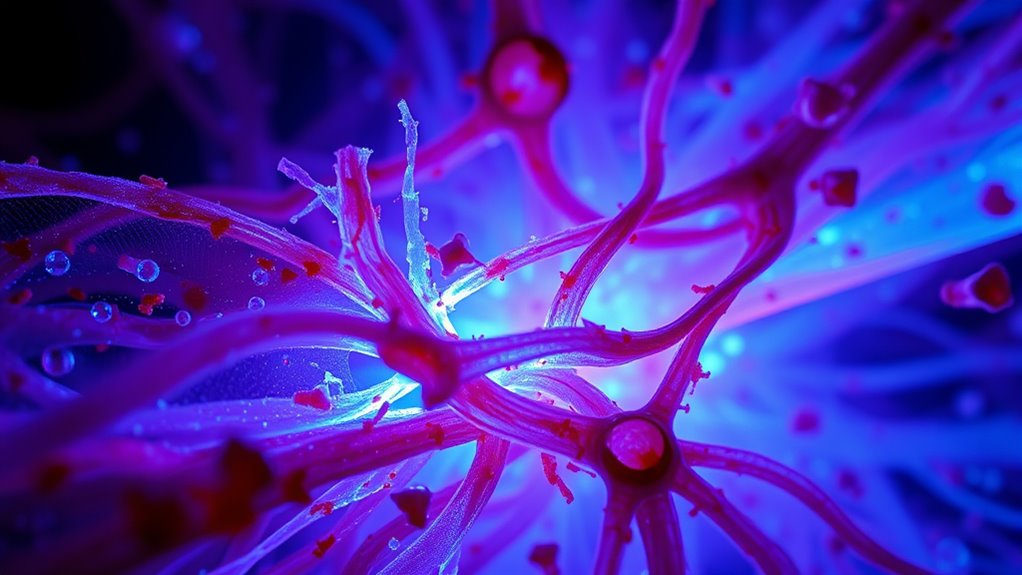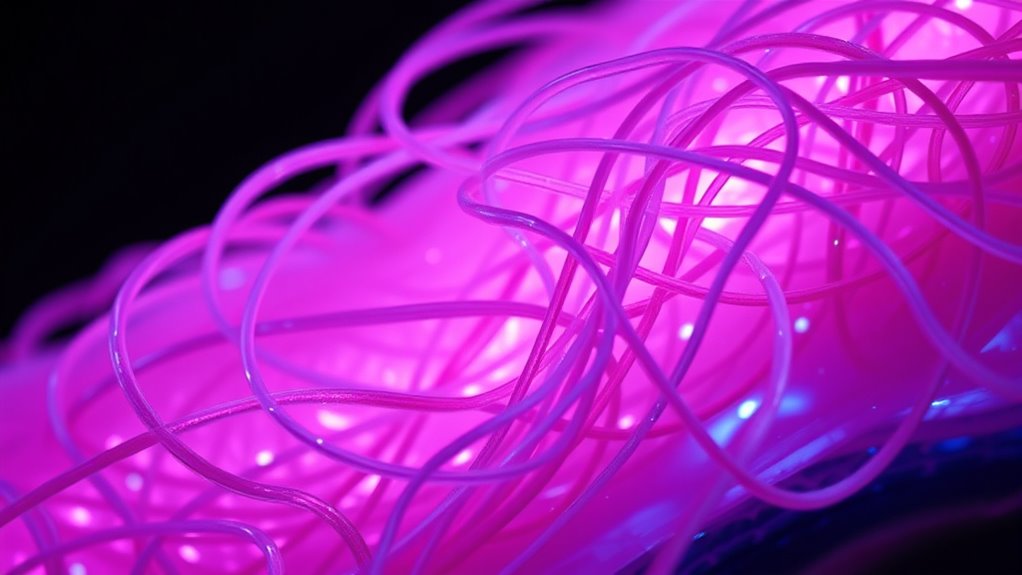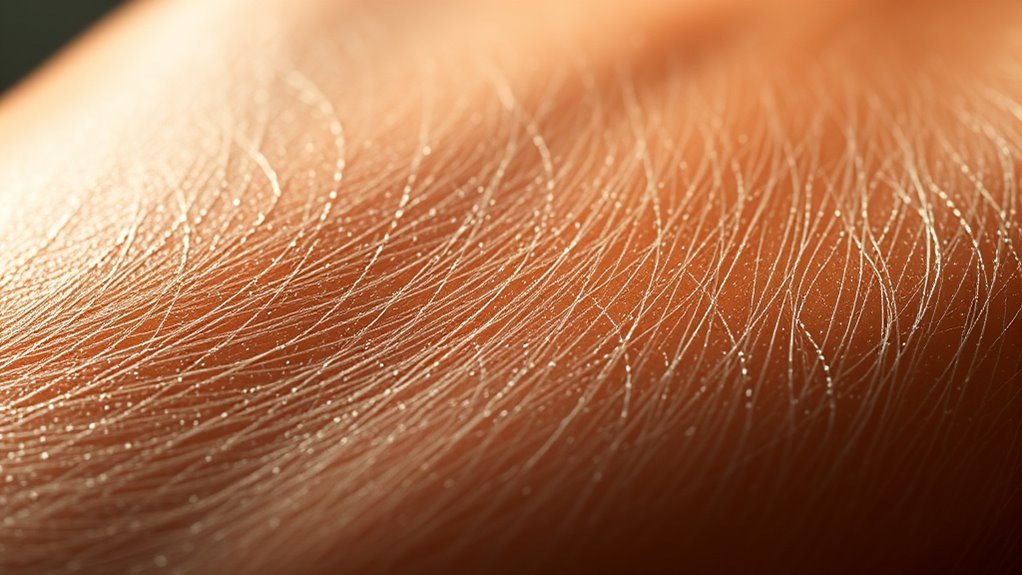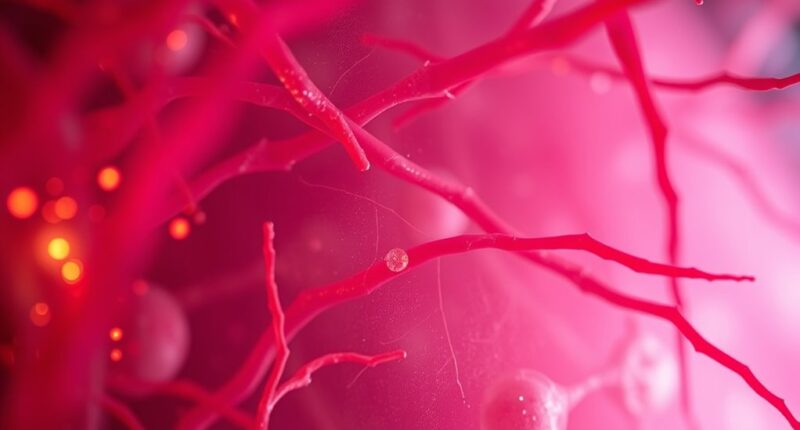After long runs, your muscle fibers experience microscopic damage, which triggers inflammation and activates immune cells to clean up the injured tissue. Satellite cells are mobilized to repair and fuse with damaged fibers, while protein synthesis strengthens muscles. Mitochondria work harder to produce energy for repair and endurance. Rest, proper nutrition, and hydration support these processes, helping your muscles recover stronger. Explore how these cellular activities work together to boost your resilience and stamina over time.
Key Takeaways
- Muscle fibers sustain microscopic damage during long runs, triggering repair processes involving inflammation and scar tissue formation.
- Satellite cells activate, multiply, and fuse with damaged fibers, promoting muscle regeneration and growth.
- Increased protein synthesis, driven by enzymes and hormones like mTOR, rebuilds and strengthens muscle tissue.
- Mitochondria adapt through biogenesis, enhancing energy production to support recovery and endurance.
- Rest, proper nutrition, and hydration optimize cellular repair mechanisms, ensuring effective muscle rebuilding.
Muscle Fiber Damage and the Body’s Response

When you finish a long run, your muscle fibers sustain microscopic damage, which triggers the body’s natural response. This damage temporarily reduces muscle elasticity, making your muscles feel tight and stiff. Nerve signaling plays a vital role here, as it detects the injury and communicates with your brain. This signaling prompts your body to activate repair mechanisms, sending signals for increased blood flow and nutrient delivery to the affected areas. The damage also stimulates the production of new proteins, helping rebuild and strengthen muscle fibers. Over time, this process restores your muscles’ elasticity and resilience. Additionally, the integration of advanced machine learning algorithms can optimize personalized recovery plans based on individual progress and needs. Understanding this cellular response helps you appreciate why proper recovery is essential for ideal muscle repair and future performance. Cellular repair processes are crucial in restoring muscle function after injury. Additionally, indexed annuities can serve as a financial tool to ensure stable income during recovery periods in retirement. Recognizing the importance of muscle regeneration can further enhance recovery strategies and long-term muscle health.
The Role of Inflammation in Repairing Muscles

Inflammation plays a crucial role in muscle repair after long runs, acting as the body’s natural response to injury. When muscles sustain damage, your immune response activates, sending immune cells to the affected area. These cells clear out damaged tissue and release signals that promote healing. This process also triggers the formation of scar tissue, which temporarily stabilizes the muscle. While scar tissue helps protect the area, excessive inflammation can prolong soreness or cause further damage. Managing inflammation through proper rest, nutrition, and recovery techniques helps optimize repair. An understanding of contrast ratio can also help in selecting the right lighting conditions to monitor recovery progress. Additionally, emerging technologies like AI-powered nanobots are being explored for their potential to accelerate tissue regeneration and improve recovery outcomes. Furthermore, inflammation management strategies are essential to prevent chronic issues and ensure optimal healing. Recognizing the importance of immune response in healing processes can further enhance recovery strategies. Ultimately, inflammation sets the stage for rebuilding, ensuring your muscles regain strength and resilience after intense activity. Understanding this process highlights how your body naturally works to heal and prepare you for future runs.
Satellite Cells: The Muscle’s Repair Squad

Satellite cells are specialized stem cells that spring into action whenever your muscles sustain damage, playing a vital role in repair and growth. When you finish a long run, these cells become activated through satellite cell activation, which signals them to leave their resting state. Once activated, they multiply rapidly and migrate to the site of injury, where they fuse with damaged muscle fibers. This process kickstarts muscle regeneration, helping your muscles recover stronger and more resilient. Satellite cells act as the muscle’s repair squad, ensuring that damaged tissue is replaced efficiently. Their ability to respond quickly and effectively is essential for adapting to the stress of endurance training, allowing your muscles to rebuild and improve with each run. Additionally, understanding how these cells function can inform strategies to optimize muscle recovery and enhance athletic performance. Recent research highlights that cell signaling pathways are crucial in regulating satellite cell activity, which could lead to targeted therapies to boost recovery.
Protein Synthesis and Muscle Reinforcement

After a long run, your muscles kickstart protein synthesis to rebuild and strengthen. This process involves activating repair signals and producing new muscle proteins. Consuming the right nutrients helps support this essential rebuilding work.
Muscle Protein Production
When you engage in long runs, your muscles respond by increasing protein production, which is crucial for repair and growth. This process, called muscle protein production, promotes muscle hypertrophy, making your muscles stronger and more resilient. During recovery, enzymes activate to facilitate the synthesis of new muscle proteins, rebuilding damaged fibers. The activation of these enzymes accelerates the process, ensuring that your muscles adapt efficiently to the stress of running. As protein production ramps up, your muscles reinforce their structure, leading to improved endurance and strength over time. This cellular activity is essential for recovery, helping you bounce back faster and prepare for future runs. Essentially, muscle protein production is the foundation of muscle reinforcement after long-distance running.
Repair Signal Activation
As your muscles ramp up protein production during recovery, specific signals activate to coordinate this process. Hormonal regulation plays a key role, with hormones like insulin and growth factors signaling cells to boost protein synthesis. Cellular signaling pathways, such as the mTOR pathway, respond to these hormonal cues, triggering muscle repair mechanisms. When activated, these pathways increase the production of new proteins, reinforcing muscle fibers and restoring strength. This activation is tightly controlled, ensuring that repair occurs efficiently without overproduction. The interplay between hormonal signals and cellular signaling ensures your muscles rebuild effectively after long runs. By precisely coordinating these signals, your body promotes muscle reinforcement, helping you recover faster and prepare for future activity.
Nutrients Supporting Synthesis
Consuming the right nutrients is essential to support protein synthesis and muscle reinforcement following long runs. Your body needs amino acids to rebuild damaged muscle fibers and antioxidant vitamins to reduce oxidative stress. Focus on foods rich in essential amino acids, like lean meats, dairy, and plant-based sources such as beans and quinoa. Antioxidant vitamins, such as vitamins C and E, help neutralize free radicals produced during exercise, promoting recovery. Proper nutrition accelerates muscle repair, enhances strength, and reduces soreness. To optimize recovery, include a combination of protein sources, fruits, and vegetables in your post-run meals. Staying well-nourished ensures your muscles rebuild stronger, ready for your next run. Prioritize these nutrients to support your body’s natural repair processes efficiently.
Mitochondria: Powering Recovery and Endurance

Mitochondria, often called the powerhouses of your cells, play a crucial role in recovery and endurance after long runs. During exercise, your body stimulates mitochondrial biogenesis, increasing their number and efficiency to meet energy demands. This process helps you recover faster and build stamina over time. As you push through long runs, oxidative stress can build up, damaging mitochondria if not managed properly. Regular training enhances your mitochondria’s ability to handle oxidative stress by boosting antioxidant defenses, protecting your cells from damage. Well-functioning mitochondria provide the energy needed for muscle repair and adaptation, making them essential for both recovery and endurance. By fostering mitochondrial health, you support your muscles’ ability to rebuild stronger and more resilient after each long run.
The Importance of Rest and Nutrition in Muscle Recovery

Rest and proper nutrition are essential components of muscle recovery, especially after long runs. When you rest, your body repairs damaged muscle fibers and replenishes energy stores. Good nutrition provides the nutrients needed for rebuilding, including protein, carbs, and healthy fats. Hydration importance can’t be overstated, as water helps transport nutrients and flush out toxins. Sleep quality plays a pivotal role in recovery by supporting cellular repair and hormone regulation. To optimize recovery, focus on:
- Drinking enough water to stay hydrated
- Consuming a balanced meal with protein and carbs post-run
- Prioritizing sleep to enhance tissue repair
- Incorporating anti-inflammatory foods for reduced soreness
Frequently Asked Questions
How Long Does Muscle Repair Typically Take After a Long Run?
After a long run, you might experience muscle soreness, which signals your muscles are repairing. Usually, the recovery timeline varies, but most muscle repair occurs within 24 to 72 hours. During this period, your body works to fix tiny tears in muscle fibers. To accelerate recovery, rest, hydrate, and eat protein-rich foods. Listening to your body helps prevent injury and ensures your muscles rebuild stronger.
Can Stretching Speed up Muscle Recovery Post-Run?
Stretching can offer flexibility benefits and may help reduce muscle tension after a long run, but it doesn’t necessarily speed up recovery. Timing matters—gentle stretching post-run can ease soreness, while overstretching might cause injury. Incorporate light stretching within 15-30 minutes after your run to promote blood flow and flexibility benefits, but avoid intense stretches immediately afterward. This approach supports your muscles’ healing process and aids in quicker recovery.
Are There Specific Foods That Enhance Muscle Rebuilding?
You might think a magic pill exists, but nope—food choices matter more. Focus on nutrient timing by eating protein-rich foods and carbs soon after your run. Dietary supplements like BCAAs or creatine can help, but real food is best. It’s ironic how simple meals can boost muscle rebuilding, yet many overlook their plate. So, fuel smartly to support recovery and get back to running stronger.
Does Hydration Impact Muscle Repair Efficiency?
Hydration levels and electrolyte balance play a vital role in muscle repair efficiency. When you stay well-hydrated, your body can deliver nutrients and remove waste products more effectively, speeding up recovery. Proper electrolyte balance ensures muscles function properly and reduces cramping or soreness. By drinking enough water and replenishing electrolytes, you support cellular processes involved in muscle rebuilding, helping you recover faster and return to activity stronger.
How Does Age Affect Muscle Recovery After Endurance Exercise?
Did you know recovery time increases by about 2-3% per decade after age 30? As you age, there’s an age-related decline in muscle repair efficiency, meaning it takes longer for your muscles to recover after endurance exercise. This decline affects your strength and performance, making it essential to prioritize proper rest, nutrition, and recovery strategies to support muscle rebuilding as you get older.
Conclusion
After a long run, your muscles face damage, but they also hold the power to rebuild stronger. While inflammation and satellite cells work tirelessly, rest and nutrition act as the silent partners in recovery. Think of your muscles as both fragile and resilient—each strain reveals vulnerability, yet also the opportunity to grow stronger. Embrace the recovery process, knowing that in every moment of rest, you’re laying the foundation for your next, even more powerful run.









